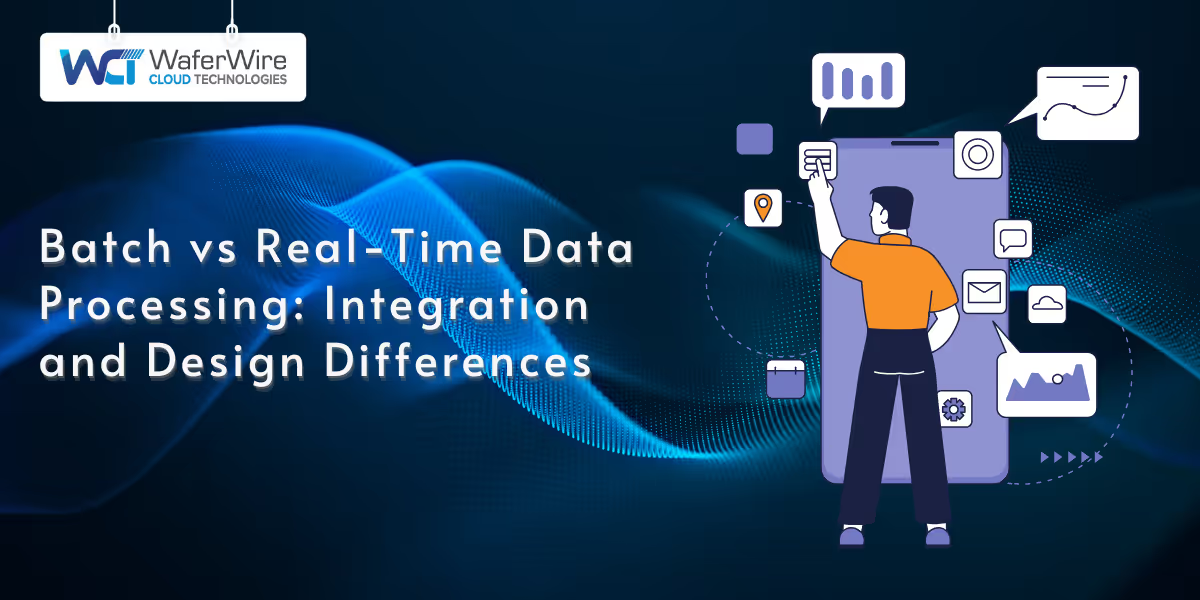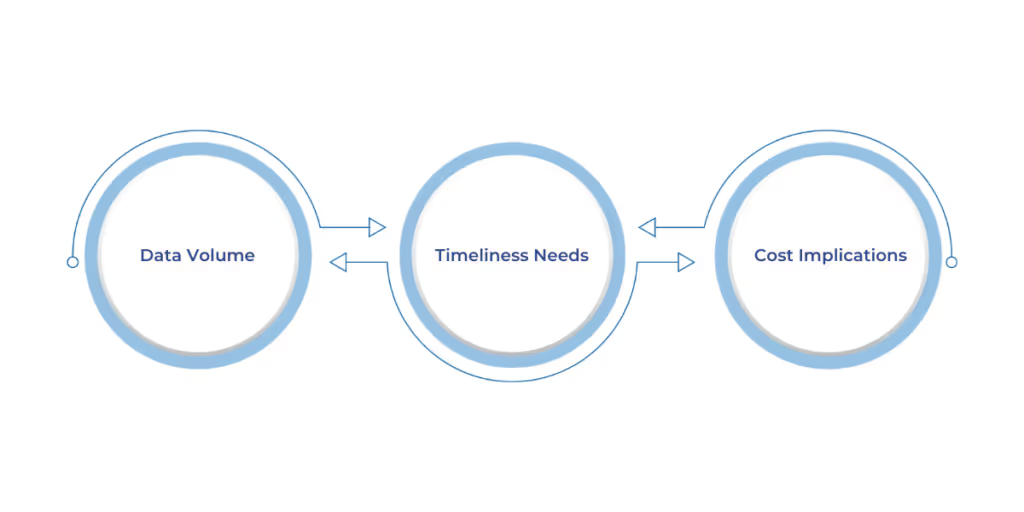

We can all agree that data is crucial for making informed business decisions. But how exactly is this data processed? Batch and real-time data refresh are the two primary methods for handling information. However, data integration goes beyond just these two approaches, adding layers of complexity to the process. Let’s break down how each method works and explore the key differences in design and integration.
Data processing is essential for effective business decision-making. Your choice of batch processing or real-time updates significantly affects how quickly your business can address opportunities and challenges. It is important to comprehend the distinctions between these methods and identify which one best aligns with your organization's goals.
Batch processing involves collecting and processing data in chunks at scheduled intervals. This method is ideal for tasks that don’t require immediate feedback, such as generating reports at the end of the day or weekly data backups. It’s an efficient way to handle large volumes of data with minimal resources.
On the other hand, real-time processing involves continuous data processing as the data is generated. This method is designed to provide immediate results, which is critical for industries that need fast, real-time decision-making, such as e-commerce or finance.
Several factors influence the choice between batch and real-time data refresh. Batch processing is often more cost-effective and efficient for businesses that need to analyze large amounts of historical data. However, companies that require immediate insights, such as those in healthcare or retail, may benefit more from real-time processing.
Understanding the nature of your data and business requirements will guide this decision.
After discussing the basics of data processing techniques, we will delve deeper into batch data processing and examine its benefits, challenges, and recommended practices.
Batch processing is a method where data is collected, processed, and stored in large chunks at scheduled intervals. It is ideal for operations that don’t require immediate processing or real-time updates. This method enables businesses to handle large volumes of data efficiently without overwhelming their systems during peak hours.
In batch processing, data is gathered over time and processed together at a later, pre-set time. This approach is ideal for operations that don't require immediate analysis but still need to process large volumes of data in a structured way. For instance, an organization might collect transaction data throughout the day and process it at night when system demand is lower.
Batch processing works by scheduling jobs to run at specific times, usually in the background. This helps businesses manage large amounts of data, such as customer orders or system logs, without overloading systems during peak hours. Key components include data collection, scheduled processing, and processing large volumes at once, ensuring that data is handled efficiently and securely.
While batch processing works well for scheduled operations, some businesses need real-time insights. Real-time data processing offers instant updates, allowing organizations to react faster to changing conditions. Let’s explore how it works.
Unlike batch processing, where data is processed in large intervals, real-time processing handles data as it is generated, providing immediate results and insights. This approach is essential for businesses that need quick decision-making and immediate actions based on the latest data.
Real-time data processing involves collecting and processing data as soon as it is created or received. The key difference here is the instant integration of data, which allows businesses to act in the moment rather than waiting for a batch process to complete.
Real-time data processing requires robust infrastructure capable of handling continuous data streams. Components like event-driven architectures, message brokers, and streaming data platforms are essential for quickly processing data and making it actionable. A real-time system ensures that updates occur as soon as new data arrives, ensuring that businesses always have the most up-to-date information available for decision-making.
This ability to process and update data instantly offers significant advantages in industries like finance, healthcare, and retail, where timely information is critical.
Now that we’ve explored real-time data processing, let’s focus on the integration and design aspects of batch and real-time data refresh methods and how they impact your data strategy.
Integration strategies for batch and real-time data refresh differ significantly. The method you choose depends largely on your business needs, the type of data, and how quickly you need access to it. Designing an efficient system for either batch or real-time processing requires attention to several key components and trade-offs.
Batch processing is best suited for handling large amounts of data that do not require immediate processing. Integration involves aggregating data over time and processing it in bulk, often at scheduled intervals. This method works well for back-office processes, like payroll or monthly financial reports, where time sensitivity is not critical.
In contrast, real-time processing requires systems to monitor and process incoming data continuously. This approach is essential for businesses that need instant insights, such as financial services or e-commerce platforms. Real-time integration involves building systems capable of capturing, processing, and updating data as it is generated, providing businesses with up-to-the-minute insights.
The system design for batch processing must ensure that data can be collected in bulk and processed orderly without impacting system performance. Key considerations include scheduling, resource allocation, and minimizing downtime during data processing.
In contrast, real-time data processing requires a more complex design. It needs to handle data continuously, with low latency, and ensure the system can scale quickly to accommodate fluctuations in data volume. Real-time systems rely on stream processing, event-driven architectures, and robust integration tools to maintain constant data flow without delays.
Whether designing for batch or real-time processing, both methods must focus on data accuracy, security, and consistency while keeping the system scalable and future-proof.
Now let us discuss the benefits and drawbacks of real-time and batch data refreshes, as well as how they affect your data strategy.
Understanding the batch and real-time data refresh methods means weighing their advantages and disadvantages. While both offer distinct benefits, their drawbacks must also be considered to ensure the right fit for your business.
Aspect Advantages Disadvantages Batch Processing
-Cost-effective: Efficient for handling large volumes of data that don't require immediate processing.
- System Optimization: Schedules data handling during off-peak hours, reducing system strain and saving resources.
- Resource Efficiency: Minimizes the need for high infrastructure costs, as it processes data in bulk.
- Lack of Timeliness: Data is processed at scheduled intervals, meaning it does not reflect real-time changes.
- Data Staleness: This results in outdated data that may hinder fast decision-making.
- Limited Flexibility: Batch processing isn’t suitable for dynamic or time-sensitive data needs.Real-Time Processing
- Immediate Data Accuracy: Provides access to the most current data as it’s generated, ensuring instant updates.
- Improved Customer Experience: Real-time data enables quick responses to customer needs, such as instant transactions in e-commerce.
- Enhanced Decision-Making: Enables quicker, informed decisions with up-to-date insights.
- High Costs: Real-time systems require more advanced infrastructure, which increases operational costs.
- System Complexity: More complex to implement and maintain due to continuous data processing.
- Scalability Challenges: Handling high data volumes in real-time demands robust systems that can scale with demand.
After a solid understanding of each processing method's advantages and disadvantages, the next step is to evaluate the criteria for choosing the right one for your business needs.
When deciding between batch and real-time data refresh, several factors must align with your business goals and technical requirements. Understanding the specifics of your data, business needs, and available resources will help you select the best method for processing and integrating data effectively.

The volume of data you process, the speed at which you need updates, and the associated costs are the primary factors to consider when choosing between batch and real-time data processing.
Batch processing is perfect for tasks where speed is less important. It is best suited for situations involving large volumes of data that don’t require immediate action. Here are some examples:
In contrast, real-time processing is essential for businesses that need to act on data as soon as it’s generated. Industries that require immediate updates and responses benefit from real-time data processing:
Businesses aiming to optimize data processing must choose between batch and real-time data refresh. Each method has distinct advantages and challenges. The right method depends on several factors, including the volume of data, the need for speed, and the available resources. If your business requires up-to-date data for quick decisions, real-time processing is the clear choice. However, if your operations can tolerate processing data at regular intervals, batch processing is a cost-effective and efficient solution.
At WaferWire, we understand that selecting the right data processing method is essential to your business's success. Whether you need the speed of real-time data or the efficiency of batch processing, we offer tailored solutions to help you seamlessly integrate batch and real-time data refresh. Our expert team will guide you through the entire process.
Contact us today to discuss how we can help transform your data strategy and deliver faster, smarter, and more informed business decisions.

